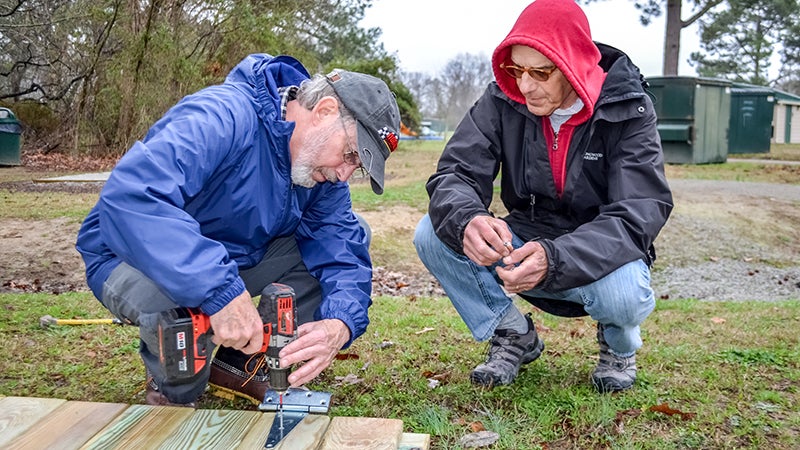Oyster shells wanted
Published 10:57 pm Thursday, March 1, 2018

- Chesapeake Bay Foundation volunteers Don Bray and Michael Berg drill a door hinge into place for the oyster collection bin built at Bennett’s Creek Park on Thursday.
Dreary skies with rain and mud couldn’t stop the Chesapeake Bay Foundation from building its first oyster shell recycling bin in Suffolk.
About 10 CBF volunteers, interns and staff worked in the gray Thursday morning at Bennett’s Creek Park. They drilled, cut and hammered lumber donated by the American Environment Foundation. The team was eager in the rain with the smells of fresh cut wood and sharp hum of saws and drills.
“We’re hoping to get this up before the rain gets too heavy,” said Don Bray, Virginia Beach resident and CBF volunteer.
The eight-by-eight-foot container was finished beside the parking lot in front of the boat ramp and fishing pier in about two hours.
“I’ve never seen it be put together so fast,” said Oyster Restoration Specialist Heather North. “People working with their own tools that they brought helped a lot. We have a great network of volunteers. I can come out in the rain, and 10 to 12 people will still show up.”
The CBF bin at Bennett’s Creek Park is the 17th by CBF throughout Virginia, North said. The bin is designed to be low enough for citizens and volunteers to simply walk up and dump their empty oyster shells, plus clam shells.
“This bin will help get Suffolk on the map for oyster recycling, so we can start making a footprint in this are,” North said.
Volunteers visit homes and partnering restaurants — such as River Stone Chophouse in Suffolk — to collect oyster shells to store in the nearest oyster recycling bin. North said the bin at Bennett’s Creek costs about $550 to $600 for materials and a sign that explains the bin’s purpose, ready to make the commute for Suffolk volunteers that much easier.
Their goal is aligned with the Chesapeake 10 Billion Oysters Partnership, a coalition of nonprofits, community groups, oyster growers and others committed to adding 10 billion new oysters to the Chesapeake Bay by 2025, according to tenbillionoysters.org.
“We know the ecological and economical benefits of oysters,” North said. “Everybody wants an oyster from the Bay.”
The CBF recycles 2,000 bushels of oyster shells annually to build new habitats for oysters planted in the Bay and its rivers. Volunteers collect the shells when the bins are near capacity. At Bennett’s Creek, fishermen will be able to just dump their empty shells after docking.
Recycled shells are cleaned, cured and placed in water tanks containing millions of microscopic oyster larvae, according to cbf.org. Each recycled shell can become home to dozens of baby oysters called spat.
As of Thursday, more than 50 restaurants donate their used oyster shells to this cause, North said.
“Basically, a restaurant’s trash is our treasure,” she said.
Replenishing the oyster population in the Chesapeake Bay after it has suffered from over-harvesting, disease and habitat loss is crucial to balancing the bay’s ecosystem. Oysters are natural water filters, and just one can filter more than 50 gallons in a single day, according to chesapeakebay.net.
That’s why college students, retired builders, photographers and everyone in between are working together to bring the oysters back.
“I’ve got five grandchildren, and I’m not going to leave them a messy world that they have to clean up,” CBF volunteer Joel Becker said.






